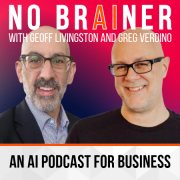The marketing conversation about AI seems to be stuck in the land of “tools and tactics.” And more often than not, the tool is ChatGPT and the tactic is cranking out content. But there’s so much more to generative AI. And there’s an entire world of “traditional” predictive AI beyond today’s generative darlings. But to get the most out of AI for your organization, you need to start thinking in terms of well-defined, strategic use cases that address real business or marketing needs — and deliver real, measurable outcomes.
In today’s episode of No Brainer, Greg and Geoff get into some real talk about use cases. What are they? How are they different from mere “usage?” How do you identify the AI use cases that matter for you? And what are some examples of smart, strategic AI use cases from leading brands?
What to Listen For
- 00:00 Start
- 03:05 Setting up today’s topic: Marketing AI Use Cases
- 04:48 There’s more to AI than ChatGPT
- 09:06 Don’t let the technology tools set your AI agenda
- 11:10 Are you stuck in a tactics trap?
- 12:17 The difference between “use” and a “use case”
- 17:09 Strategic AI projects start with a clearly defined outcome
- 26:33 Getting past the “play” stage
- 29:29 Three key use case categories
- 31:35 Using AI to solve a common sales enablement challenge
- 37:53 Cross-functional decision-making for marketing AI technology choices
- 42:05 Integrating AI into the tech stack, ChatSpot.ai (HubSpot) example
- 46:39 Use Case: Cyber Inc. scales multilingual video
- 48:35 Use Case: Volkswagen improves marketing performance with predictive AI
- 53:44 Use Cases: Coca-Cola lands and expands through strategic AI projects
- 59:36 Brainer and No Brainer Takeaways
Episode Links and Resources
- WSJ article about “workers wanting ChatGPT” while bosses say no
- Just a couple of examples of how the generative AI technology companies and even the big management consultancies default to laundry lists of tactics when trying to explain AI use cases
- ChatSpot.ai, HubSpot’s generative AI sandbox for SDRs








